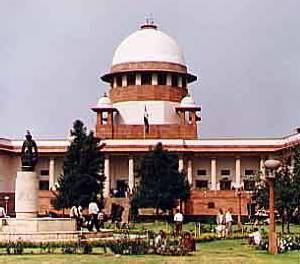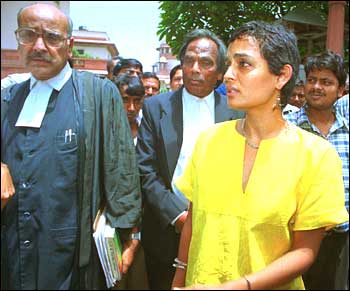 Coming
Wednesday (March 6, 2002) is an important milestone in the history
of Indian Judiciary. On this day, the Apex court of India is going
to issue its judgement on criminal contempt of court case against
the acclaimed writer and social activist Ms Arundhati Roy, who has
been championing the cause of displaced tribes in the western parts
of the country due to the large dam construction across the Narmada
river.
Coming
Wednesday (March 6, 2002) is an important milestone in the history
of Indian Judiciary. On this day, the Apex court of India is going
to issue its judgement on criminal contempt of court case against
the acclaimed writer and social activist Ms Arundhati Roy, who has
been championing the cause of displaced tribes in the western parts
of the country due to the large dam construction across the Narmada
river.
The ongoing contempt case is the third in line since 1999 against
Ms Roy. In 1999, the Supreme Court of India took offense to her essay
"The Greater Common Good" that was published in Outlook. In January
2001, again she was issued a contempt notice along with the NBA leader
MS Medha Patkar ad the lawer Prasant Bhusan, for her alleged objectionable
behaviour during the demonstration outside Supreme Court on 14th December
2000 against the final verdict delivered in the sardar Sarovar case
which allowed construction to resume on the controversial dam on the
Narmada river. Although the court relived her from this contempt case
on 28th August 2001, Justice G B Pattanaik and Justice Ruma Pal took
objection to three paragraphs in the affidavit-in-reply of Arundhati
Roy dated 16th April 2001 to the Contempt Petition (CR) No. 2/2001
and held that those three paragraphs were prima facie contemptuous.
The notice for this case, Contempt Petition (CRL) No. 10 of 2001,
was issued to Arundhati Roy on 5th September 2001as defined under
Section 2C of the Contempt of Court Act along with Article 129 of
the constitution of India. After the final hearing on 15th January
2002, the court reserved its judgement till 6th March 2002.
While this article would not go into the merits and demerits of this
case as it is sub judice, the way this case is proceeding in the Apex
court and its much-awaited judgement would have far-reaching consequence
to our democratic rights and especially the Freedom of Press. The
objective of writing this article is to highlight a few glaring conflicts
between the contempt of court and the freedom of speech assured by
our constitution. It is up to the right thinking readers to deliberate
more on this and depending on their convictions, this author requests
them to throw their weight behind this issue.
It is necessary to give the sequence of events that took place before
the court issued the second contempt petition against Ms Roy so that
one would be more educated to analyze the judgement that is to be
issued on 6th March. On 18th October 2000, the Supreme Court delivered
its final judgement on Sardar Sarovar case. On 13th December 2000,
few hundred people from the Narmada valley along with local supporters
of the Narmada Bacho Andolan (NBA) staged a day long dharna outside
the gates of the Supreme Court against its judgement as it put their
livelihood in dire straight. This dharna took place in the presence
of several senior police officials, press, and media. On 14th December
2000, Five lawyers led by Jagdish Parashar and R K Virmani attempted
to file a FIR at the Tilak Marg Police Station alleging that Medha
patkar, Arundhati Roy and Prasant Bhusan shouted filthy slogans against
the court during the dharna, also physically assaulted the petitioner
lawyers and threatened to kill them. Interestingly, the police station
did not see fit to register the case.
In January 2001, the same lawyers filed a petition in the Supreme
Court for criminal contempt of court. It is to be noted here that
the accusations were so ludicrous that the local police station declined
to file a case and the petition did not meet any of the conditions
required by the Contempt of Courts Act. It was not supported by a
proper affidavit and interestingly not signed by the Petitioners.
It did not contain the addresses of the Petitioners or the respondents.
Most crucially, the Petition did not have the consent of the Attorney
General or Solicitor General as required by the Contempt of Courts
Act.  In
spite of all these the Registry of the Supreme Court allowed this
petition. In the affidavit to Contempt Petition (CRL) No. 10 of 2001
filed by Arundhati Roy on 16th October 2001, she cited a Press report
by V. Venkatesan in Frontline dated September 28, 2001 along with
editorial inputs from its editor N. Ram to convey the point that the
Registry indeed refused to list the petition before the Court in view
of the multiple flaws. This article says that the Attorney general
had been approached and he was reportedly declined to deal with the
matter and hence the Petitioners requested the Court to take suo motu
action While this is not quoted to substantiate anything as the veracity
of the cited report can be questioned, the purpose of citing this
report is to provoke the reader to question as to why the petition
was allowed before the Court with multiple flaws. Without meeting
any of the formal requirements and without passing a minimal credibility
test, the petition was admitted and notices were issued to the Respondents.
In
spite of all these the Registry of the Supreme Court allowed this
petition. In the affidavit to Contempt Petition (CRL) No. 10 of 2001
filed by Arundhati Roy on 16th October 2001, she cited a Press report
by V. Venkatesan in Frontline dated September 28, 2001 along with
editorial inputs from its editor N. Ram to convey the point that the
Registry indeed refused to list the petition before the Court in view
of the multiple flaws. This article says that the Attorney general
had been approached and he was reportedly declined to deal with the
matter and hence the Petitioners requested the Court to take suo motu
action While this is not quoted to substantiate anything as the veracity
of the cited report can be questioned, the purpose of citing this
report is to provoke the reader to question as to why the petition
was allowed before the Court with multiple flaws. Without meeting
any of the formal requirements and without passing a minimal credibility
test, the petition was admitted and notices were issued to the Respondents.
The Supreme Court dismissed the petition on 28th August 2001 as they
felt it to be grossly defective and unsubstantiated. They held that
the Registry of the Court should have not even accepted the petition.
The Court took exception to the reluctance of the four Petitioners
to even affirm an affidavit verifying the facts contained in the Petition.
However, Justice G B Pattanaik and Justice Ruma Pal took objection
to three paragraphs in the affidavit of Ms Roy. In those paragraphs,
she sort of questioned that if the Chief justice of India refused
to allow a sitting judge to head the judicial enquiry into the Tehelka
scandal (involving matters of national security and corruption in
the highest places) on the grounds that judges of the supreme Court
are too busy, how did they find time to slap a contempt petition on
her, Medha and Prasant Bhusan in spite of the fact that the petition
was shabbily drafted and procedurally grossly defective. Based on
this contradiction, Arundhati Roy remarked in her affidavit that the
Supreme Court displayed a disturbing willingness to issue the Contempt
notice. She went on to add in her affidavit-reply that this action
of the Court "indicated a disquieting inclination on the part of the
Court to silence criticism and muzzle dissent, to harass and intimidate
those who disagree with it". She also added that "by entertaining
a petition base don an FIR that even a local police station does not
see fit to act upon, the Supreme Court is doing its own reputation
and credibility considerable harm".
The above remarks contained in three paragraphs of
Arundhathi Roy's affidavit dated 16th April 2001 were considered to
be "scandalous and contumacious statements". The Court held that "She
had imputed motives to specific courts for entertaining litigation
or passing orders against her". The Court also held that" She has
accused Courts of 'harassing' her as if the judiciary were carrying
out a personal vendetta against her". The Court remarked that "she
brought in matters that were not only pertinent to the issues to be
decided but has drawn uninformed comparisons to make statements about
the court which do not appear to be protected by the law relating
to fair criticism". Hence, the Supreme Court on 5th September 2001
issued a fresh contempt notice to Arundhati Roy. In reply to this
notice, Ms Roy explained the circumstances based on which she spoke
her mind in the previous affidavit for which the Court took objection.
She mentioned that for a common citizen like her there is no distinction
between the court and its Registry. She maintained that the Court
found time to issue contempt notice to her when it is too busy to
take up cases like Tehelka and also referred to the action of the
petitioners who grossly abused the procedures and wasted the precious
time of the Court and still went scot-free. She clarified that she
did not mean to undermine the dignity of the court and was imply stating
an honest impression that had formed in her mind. She also added the
reasons that led to this impression on the Court. She cited the eagerness
of the Court to issue petition to her, Medha Patkar and Prasant Bhusan
in stead of dismissing it, failure to order an inquiry into the functioning
of the Registry to establish how a procedural lapse could have taken
place, and the failure to take action against the Petitioners for
filing a false case and deliberately attempting to mislead the Court
as reasons for her impression on the Court. She also referred to the
Contempt of Court case against the then Law Minister Shiv Shankar
who in his public speech accused judges of having an "unconcealed
sympathy for the haves". In that case, he was not held guilty on the
grounds that those were his personal views and he was entitled to
air them. If one can air his/her personal views against the Court
in a public speech, why should Arundhati Roy's 'impression' on the
court, that too in her affidavit (not a public remark) to the Court,
is held contemptuous? If it is to be considered contemptuous, the
interpretation of the law is whimsical and one is at the mercy of
the individual judges. It is unfortunate the Justice Pattanaik is
sitting as a judge in his own cause.
.........................To Page 02

